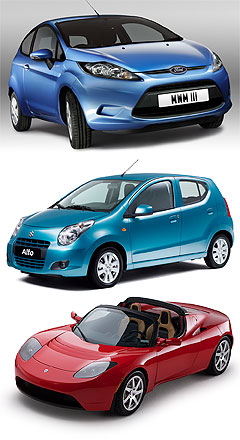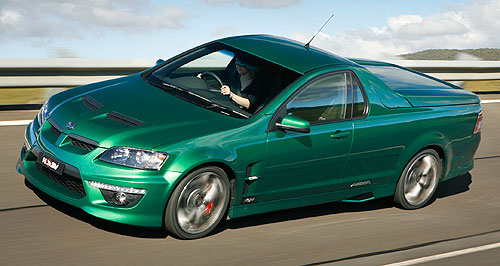Make / Model Search
News - General News - EmissionsMaloo, XR6 Turbo lay down the ChallengeGreen machine: Ford's XR6 Turbo is shooting for a Green Challenge podium. Big bangers from HSV and Ford chase fuel-sipping Green Challenge glory9 Oct 2009 TWO of Australia’s thirstier cars could end up being the unlikely stars of the 2009 Global Green Challenge – a 3000km fuel economy competition from Darwin to Adelaide on October 24-31. HSV’s 6.2-litre V8 manual Maloo R8 ute – with an official combined fuel consumption rating of 15.1 litres per 100km – and the 4.0-litre Ford Falcon XR6 Turbo – rated at 11.7L/100km in the combined ADR 81/01 test – will be shooting for a podium finish in the production car class of the event, which grew out of the World Solar Challenge. As both Ford and HSV have been quick to identify, the rules do not just measure overall consumption but the percentage of fuel saved under the official ADR fuel consumption figure. These companies figure the event – with its long stretches of straight, flat highway and only a couple of urban runs in Darwin and Adelaide – will provide ideal conditions to show just how efficient their vehicles can be with careful, steady driving. Compared with more frugal vehicles, the drivers should find it fairly easy to slice large chunks out of the official, combined urban/highway cycle used to measure every car on the Australian market.  From top: Ford Fiesta Econetic, Suzuki Alto and Telsa Roadster (bottom). From top: Ford Fiesta Econetic, Suzuki Alto and Telsa Roadster (bottom).Both cars should be able to lope along the Stuart Highway in a torquey sweet spot of the rev range and the optimum gear for maximum efficiency. According to official figures, the Maloo does 10.3L/100km on the ‘extra urban’ or highway cycle, but HSV hopes to achieve single figures. The XR6 Turbo already achieves single figures on the official highway test – 8.8L/100km – but it will be a matter of how much further it can go. Another big V8 car should also provide plenty of interest in the event, even though it is not officially entered. HSV’s support car is a prototype for its LPG-fuelled V8 E2 Series, doing double duty as a test bed for upcoming liquid-injection technology to be introduced next year by the Holden hot shop. The battle for showroom car outright honours – the vehicle which covers the 3000km on the fewest litres of fuel – is shaping up as a fight of the fuels – diesel, petrol and LPG. Of the diesels, the new 1.6-litre Ford Fiesta Econetic is one of the pre-event favourites. Set to become Australia’s most fuel-efficient vehicle when it is launched later this year, the smallest Ford has an official fuel rating of 3.7L/100km on the combined cycle and 3.2L/100km on the highway. It will be up against a small fleet of diesel Mini Cooper Ds, one of which will be driven by former Le Mans winner Vern Schuppan. Volvo’s super-efficient C30 1.6D DRIVe also was meant to have competed, but a shipping delay has forced the withdrawal of Sweden’s top chance (see separate story). Of the petrol candidates, Suzuki’s new three-cylinder 1.0-litre Alto city car is the best bet to take the glory from the diesels. On paper, it is behind the diesels, with a combined fuel rating of 4.8L/100km and highway figure of 4.3L/100km (on premium unleaded), but Suzuki believes it is up for the challenge. The diesel and petrol cars alike might be upstaged by Kia’s state-of-art gas/hybrid Forte (known in Australia as the Cerato). A pair of these 1.6-litre liquid petroleum injection (LPI) cars, which use an electric motor sandwiched between the engine flywheel and CVT transmission to boost acceleration, have been entered as a pre-cursor to the introduction of the model next year. Although no ADR figures are yet available, Korean tests show the gas-hybrid car uses a combined-cycle 5.6L/100km of LPG. Considering the price of LPG is less than half the price of petrol per litre, Kia is confident of some bragging rights by the time the Challenge reaches Adelaide. The Kia is the only showroom (in Korea) model using hybrid technology in the event. Toyota and Honda have both declined to enter their Prius and Insight, no doubt because the strength of those cars is the stop-start urban environment. On the open running of the Stuart Highway, the diesels in particular should excel. Skoda has entered its 2.0-litre diesel Superb large-car to demonstrate its fuel-sipping talents, which are officially measured at 6.3L/100km (combined) and 5.3L/100km (highway). Another large car, Holden’s 3.0-litre VE Commodore, will also be along for the ride to similarly showcase the new-found efficiencies of the SIDI (Spark Ignition Direct Injection) model – officially 9.3L/100km combined and 7.3L/100km highway. Hyundai will also go big, with its new 2.2-litre diesel Santa Fe CRDi that boasts a combined fuel figure of 7.2L/100km (5.9L/100km highway). The plug-in electric Tesla sports coupe from California’s Silicon Valley – regarded as the world’s first practical electric highway cruiser – has also been entered. It is said to be capable of a range of more than 400km per charge of its lithium-ion batteries, and will need every amp to make the distance between stops on the six stages of the journey. There will be no such issues for the more than 40 solar cars entered in the glamour zero-emissions World Solar Challenge category. These cars, entered by teams traveling from about 17 countries, will simply cruise on sublight, stopping and camping beside the highway each night at a set time.  Read more8th of October 2009  Kia takes up Challenge with gas hybrid CeratoGreen Challenge entry brings Kia Australia one step closer to 2010 Cerato LPI hybrid8th of October 2009  Ill wind blows Volvo’s Green ChallengeFrugal Volvo C30 DRIVe out of Challenge but set for better 3.8L/100km fuel economy29th of September 2009  Fuel-sipping Ford Fiesta just two months awayFord to roll out Fiesta Econetic in next month’s Global Green Car Challenge21st of July 2009  Suzuki’s Alto-egoSmall-car specialist Suzuki has big plans for first affordable sub-light model |
Click to shareGeneral News articlesResearch General News Motor industry news |











Facebook Twitter Instagram